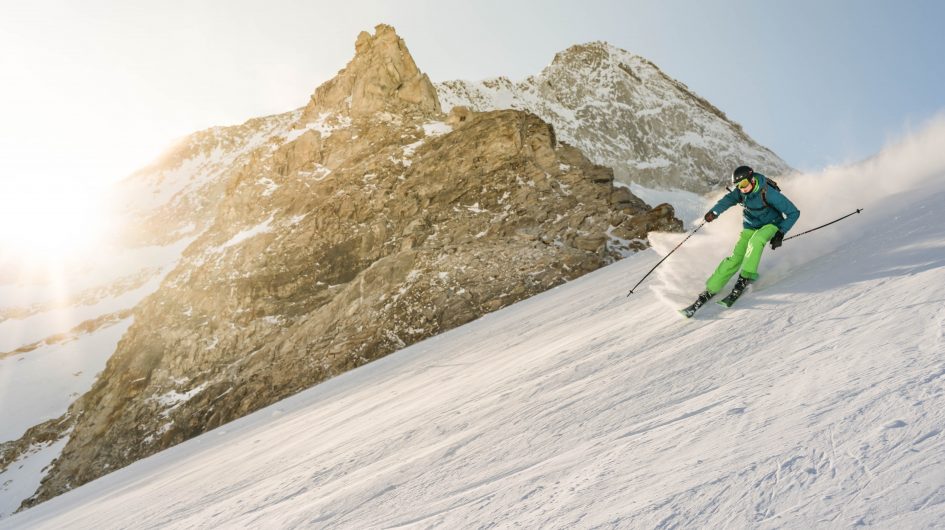Picture this scene: You are sitting on a chairlift bundled up in snow pants, a winter jacket, gloves, hat and helmet. You’re traveling up a snow-covered hill with ski poles in hand, boots on your feet, and skis (or a snowboard) attached while dangling in midair. The air is crisp and fresh; maybe snow is falling. You hear birds chirping, the sound of skis gliding through the snow, and the constant hum of the chairlift. To your left, empty chairs go past. Below, skiers and snowboarders move down the hill. You take in the views of trees and valleys. After this run, you’ll take a break in the lodge for some warm soup and a crackling fire.
Skiing and Snowboarding Benefits
One of the most cathartic and peaceful aspects of skiing is the routine. You put on gear, take your first ride up the chairlift, ski down and repeat the process. Sitting on the chairlift creates a time to reflect and take in the scenes or converse with fellow skiers.
In addition to reflection, snow skiing and snowboarding are fun ways to get exercise and fresh air during the winter, a time known for creating several hurdles to a healthy lifestyle. If you’re a beginner, most resorts offer lessons and hills that range from “bunny” level to “black diamond” (advanced). If you do not own equipment, most hills have shops that rent out skis and snowboards for users of all ages. Skiing and snowboarding is an activity the entire family can enjoy.
Skiing also has great physical health benefits. It improves proprioception, which is the ability to sense the orientation of your body in your environment. It allows you to move quickly and freely without consciously thinking about what you are doing. Skiing and snowboarding also strengthen bones and joints, increase cardiovascular endurance, strengthen lower-body muscles, improve balance and core strength, and improve flexibility.
Furthermore, snow skiing promotes deep sleep. Skiing and snowboarding engage your entire body. Skiing, paired with the fresh air, helps you sleep well. Getting outside can have positive benefits for mental wellbeing, too. The natural beauty from the snow-covered mountain can alleviate stress and vitamin D exposure can help elevate your mood.
Besides downhill skiing, another form is cross-country skiing. This provides an excellent cardio workout. The cross-country skier moves through the snow by striding forward on their skis one at a time, almost like skating. They also use poles to assist with forward motion. Ski touring is cross-country skiing along an untracked course. Groom-trail skiing uses trails already tracked and groomed.
Stay Safe While Hitting the Slopes
There are safety precautions to consider when skiing and snowboarding. While boarding the chairlift, make sure you do not have any loose clothing (scarves, loose sweatshirt strings, etc.) that could get caught on the chairlift. Sit back, do not lean forward and avoid horseplay. If you have children with you, the chairlift operator can decrease the lift speed so they can board easier. To exit, slowly inch forward in your seat when the chair is about 10 feet from the landing. Remember to keep the tips of your skis pointed skyward.
Helmets are recommended for all ages, regardless of experience and ability. Even if you are an advanced skier, chunks of ice could fall, or other skiers or snowboarders could run into you. Ski goggles are highly recommended to protect your eyes.
With temperatures below freezing, consider the possibility of frostbite. Frostbitten skin becomes very cold and red, then numb, and then hard and pale. The areas most susceptible to frostbite are fingers, toes, nose, ears, cheeks and chin. In extremely cold conditions, take a break in the lodge to warm up every hour or so.
Ski Patrol assistants are available on the slopes, usually wearing red or yellow coats, to help in an emergency. Chairlift operators can also help with questions or concerns about hill conditions. Review the ski resort map and familiarize yourself with the hills and degrees of difficulty. Black diamonds indicate advanced slopes, and beginner hills are usually marked with a green or yellow dot. During peak busy times, be aware of other skiers and snowboarders while descending hills.
Sources
http://www.healthfitnessrevolution.com/top-10-health-benefits-skiing/
https://www.verywellhealth.com/proprioception-2696141
https://www.mayoclinic.org/diseases-conditions/frostbite/symptoms-causes/syc-20372656
https://www.popularmechanics.com/adventure/outdoors/a14416161/how-to-cross-country-skiing/
https://www.mayoclinic.org/diseases-conditions/frostbite/symptoms-causes/syc-20372656

